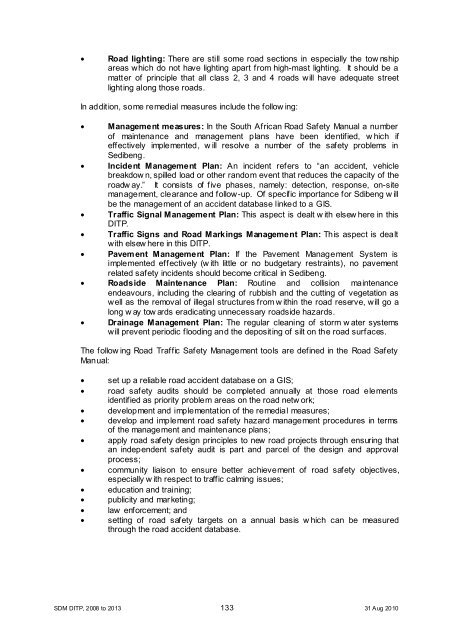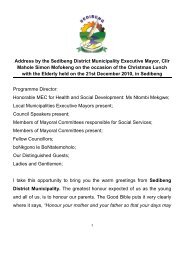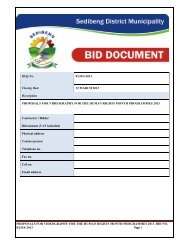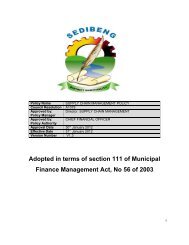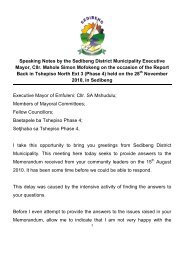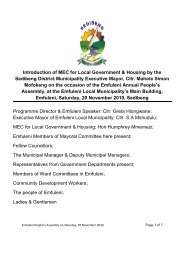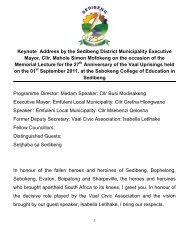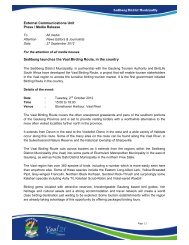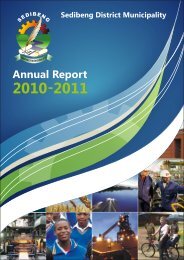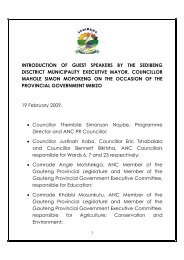Chapter 11 - Sedibeng District Municipality
Chapter 11 - Sedibeng District Municipality
Chapter 11 - Sedibeng District Municipality
Create successful ePaper yourself
Turn your PDF publications into a flip-book with our unique Google optimized e-Paper software.
• Road lighting: There are still some road sections in especially the tow nship<br />
areas which do not have lighting apart from high-mast lighting. It should be a<br />
matter of principle that all class 2, 3 and 4 roads will have adequate street<br />
lighting along those roads.<br />
In addition, some remedial measures include the follow ing:<br />
• Management measures: In the South African Road Safety Manual a number<br />
of maintenance and management plans have been identified, w hich if<br />
effectively implemented, w ill resolve a number of the safety problems in<br />
<strong>Sedibeng</strong>.<br />
• Incident Management Plan: An incident refers to “an accident, vehicle<br />
breakdow n, spilled load or other random event that reduces the capacity of the<br />
roadw ay.” It consists of five phases, namely: detection, response, on-site<br />
management, clearance and follow-up. Of specific importance for Sdibeng w ill<br />
be the management of an accident database linked to a GIS.<br />
• Traffic Signal Management Plan: This aspect is dealt w ith elsew here in this<br />
DITP.<br />
• Traffic Signs and Road Markings Management Plan: This aspect is dealt<br />
with elsew here in this DITP.<br />
• Pavement Management Plan: If the Pavement Management System is<br />
implemented effectively (w ith little or no budgetary restraints), no pavement<br />
related safety incidents should become critical in <strong>Sedibeng</strong>.<br />
• Roadside Maintenance Plan: Routine and collision maintenance<br />
endeavours, including the clearing of rubbish and the cutting of vegetation as<br />
well as the removal of illegal structures from w ithin the road reserve, will go a<br />
long w ay tow ards eradicating unnecessary roadside hazards.<br />
• Drainage Management Plan: The regular cleaning of storm w ater systems<br />
will prevent periodic flooding and the depositing of silt on the road surfaces.<br />
The follow ing Road Traffic Safety Management tools are defined in the Road Safety<br />
Manual:<br />
• set up a reliable road accident database on a GIS;<br />
• road safety audits should be completed annually at those road elements<br />
identified as priority problem areas on the road netw ork;<br />
• development and implementation of the remedial measures;<br />
• develop and implement road safety hazard management procedures in terms<br />
of the management and maintenance plans;<br />
• apply road safety design principles to new road projects through ensuring that<br />
an independent safety audit is part and parcel of the design and approval<br />
process;<br />
• community liaison to ensure better achievement of road safety objectives,<br />
especially w ith respect to traffic calming issues;<br />
• education and training;<br />
• publicity and marketing;<br />
• law enforcement; and<br />
• setting of road safety targets on a annual basis w hich can be measured<br />
through the road accident database.<br />
SDM DITP, 2008 to 2013 133 31 Aug 2010


